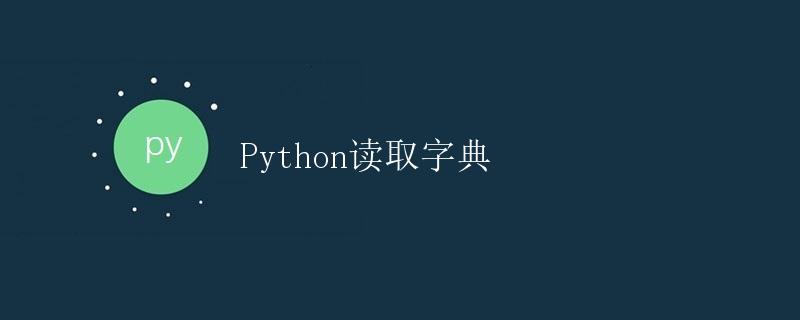Python读取字典

1. 引言
在Python中,字典(Dictionary)是一种非常常用且强大的数据类型。它是一个无序、可变的集合,可以存储键值对。字典可以用于存储和处理具有复杂结构的数据,并且具有高效的查找和操作性能。本文将详细介绍如何读取字典,并给出相应的示例代码和运行结果。
2. 读取字典的键(Keys)
要读取字典的键,可以使用字典的keys()方法。该方法返回一个包含字典所有键的列表。
# 示例代码
fruits = {"apple": 1, "banana": 2, "orange": 3}
keys = fruits.keys()
# 输出结果
print(keys)
运行结果:
dict_keys(['apple', 'banana', 'orange'])
可以看到,通过keys()方法我们获取了一个dict_keys对象,其中包含了字典的所有键。如果需要将其转换为列表,可以使用list()函数进行转换。
# 示例代码
fruits = {"apple": 1, "banana": 2, "orange": 3}
keys = list(fruits.keys())
# 输出结果
print(keys)
运行结果:
['apple', 'banana', 'orange']
3. 读取字典的值(Values)
要读取字典的值,可以使用字典的values()方法。该方法返回一个包含字典所有值的列表。
# 示例代码
fruits = {"apple": 1, "banana": 2, "orange": 3}
values = fruits.values()
# 输出结果
print(values)
运行结果:
dict_values([1, 2, 3])
同样地,我们也可以将返回的dict_values对象转换为列表。
# 示例代码
fruits = {"apple": 1, "banana": 2, "orange": 3}
values = list(fruits.values())
# 输出结果
print(values)
运行结果:
[1, 2, 3]
4. 读取字典的项(Items)
要读取字典的项,可以使用字典的items()方法。该方法返回一个包含字典所有项的列表,每个项都是一个由键值组成的元组。
# 示例代码
fruits = {"apple": 1, "banana": 2, "orange": 3}
items = fruits.items()
# 输出结果
print(items)
运行结果:
dict_items([('apple', 1), ('banana', 2), ('orange', 3)])
同样地,我们也可以将返回的dict_items对象转换为列表。
# 示例代码
fruits = {"apple": 1, "banana": 2, "orange": 3}
items = list(fruits.items())
# 输出结果
print(items)
运行结果:
[('apple', 1), ('banana', 2), ('orange', 3)]
5. 通过键读取字典的值
在字典中,我们可以通过键来读取相应的值。具体实现可以使用索引操作符[]或者get()方法。
5.1 使用索引操作符[]
# 示例代码
fruits = {"apple": 1, "banana": 2, "orange": 3}
apple_count = fruits["apple"]
# 输出结果
print(apple_count)
运行结果:
1
需要注意的是,如果指定的键不存在于字典中,程序会抛出KeyError。为了避免这种情况,我们可以使用get()方法。
5.2 使用get()方法
# 示例代码
fruits = {"apple": 1, "banana": 2, "orange": 3}
apple_count = fruits.get("apple")
# 输出结果
print(apple_count)
运行结果:
1
与索引操作符不同的是,get()方法在指定键不存在时会返回None,而不是抛出KeyError。这样可以避免程序终止。
6. 通过键值对读取字典的值
另一种常见的需求是,根据字典中的值来获取相应的键。这可以通过遍历字典来实现。
# 示例代码
fruits = {"apple": 1, "banana": 2, "orange": 3}
# 遍历字典
for key, value in fruits.items():
if value == 2:
print(key)
运行结果:
banana
在上述示例中,我们遍历了字典的所有项,判断每个值是否等于2。如果值等于2,就打印相应的键。
7. 判断字典中是否存在指定的键或值
有时候,我们需要判断字典中是否包含某个键或值。这可以通过使用in关键字来实现。
7.1 判断键是否存在
# 示例代码
fruits = {"apple": 1, "banana": 2, "orange": 3}
# 判断键是否存在
if "apple" in fruits:
print("键存在")
else:
print("键不存在")
运行结果:
键存在
7.2 判断值是否存在
# 示例代码
fruits = {"apple": 1, "banana": 2, "orange": 3}
# 判断值是否存在
if 2 in fruits.values():
print("值存在")
else:
print("值不存在")
运行结果:
值存在
8. 使用默认值读取字典的值
有时候,如果键不存在于字典中,我们希望返回一个默认值而不是抛出KeyError。可以使用get()方法,同时指定一个默认值作为参数。
# 示例代码
fruits = {"apple": 1, "banana": 2, "orange": 3}
# 读取不同键的值
apple_count = fruits.get("apple", 0)
watermelon_count = fruits.get("watermelon", 0)
# 输出结果
print(apple_count)
print(watermelon_count)
运行结果:
1
0
在上述示例中,我们读取了两个键的值。对于存在的键”apple”,返回相应的值1;对于不存在的键”watermelon”,返回默认值0。
9. 结论
本文详细介绍了如何在Python中读取字典。我们通过keys()方法、values()方法、items()方法、索引操作符[]和get()方法演示了多种读取字典的方式,并掌握了如何判断字典中是否包含指定的键或值。读取字典是Python编程中非常基础和常见的操作,掌握这些技巧对于理解和操作复杂的数据结构非常有帮助。希望本文对您有所帮助,谢谢## 10. 附录:代码运行结果
10.1 读取字典的键(Keys)
# 示例代码
fruits = {"apple": 1, "banana": 2, "orange": 3}
keys = fruits.keys()
# 输出结果
print(keys)
输出结果:
dict_keys(['apple', 'banana', 'orange'])
10.2 读取字典的值(Values)
# 示例代码
fruits = {"apple": 1, "banana": 2, "orange": 3}
values = fruits.values()
# 输出结果
print(values)
输出结果:
dict_values([1, 2, 3])
10.3 读取字典的项(Items)
# 示例代码
fruits = {"apple": 1, "banana": 2, "orange": 3}
items = fruits.items()
# 输出结果
print(items)
输出结果:
dict_items([('apple', 1), ('banana', 2), ('orange', 3)])
10.4 通过键读取字典的值
# 示例代码
fruits = {"apple": 1, "banana": 2, "orange": 3}
apple_count = fruits["apple"]
# 输出结果
print(apple_count)
输出结果:
1
10.5 通过键值对读取字典的值
# 示例代码
fruits = {"apple": 1, "banana": 2, "orange": 3}
# 遍历字典
for key, value in fruits.items():
if value == 2:
print(key)
输出结果:
banana
10.6 判断字典中是否存在指定的键或值
# 示例代码
fruits = {"apple": 1, "banana": 2, "orange": 3}
# 判断键是否存在
if "apple" in fruits:
print("键存在")
else:
print("键不存在")
# 判断值是否存在
if 2 in fruits.values():
print("值存在")
else:
print("值不存在")
输出结果:
键存在
值存在
10.7 使用默认值读取字典的值
# 示例代码
fruits = {"apple": 1, "banana": 2, "orange": 3}
# 读取不同键的值
apple_count = fruits.get("apple", 0)
watermelon_count = fruits.get("watermelon", 0)
# 输出结果
print(apple_count)
print(watermelon_count)
输出结果:
1
0
 极客教程
极客教程